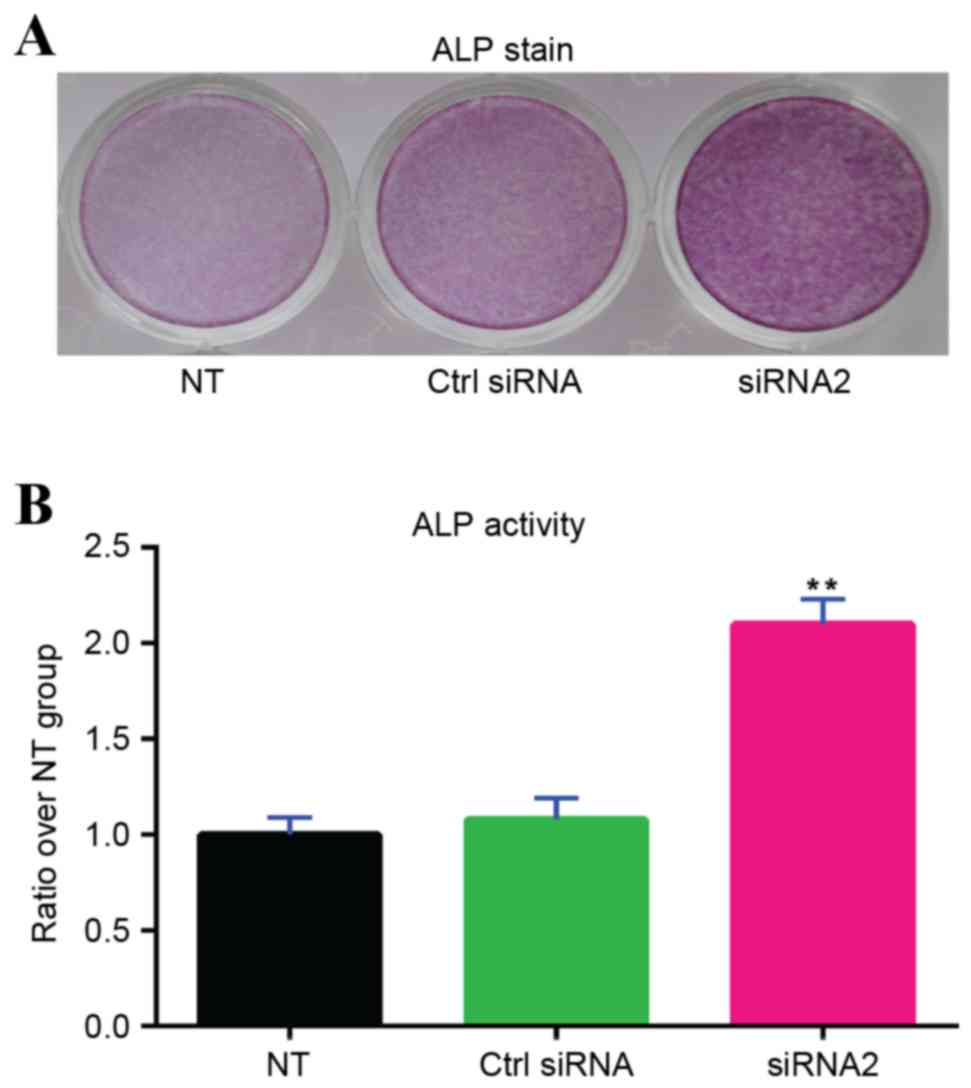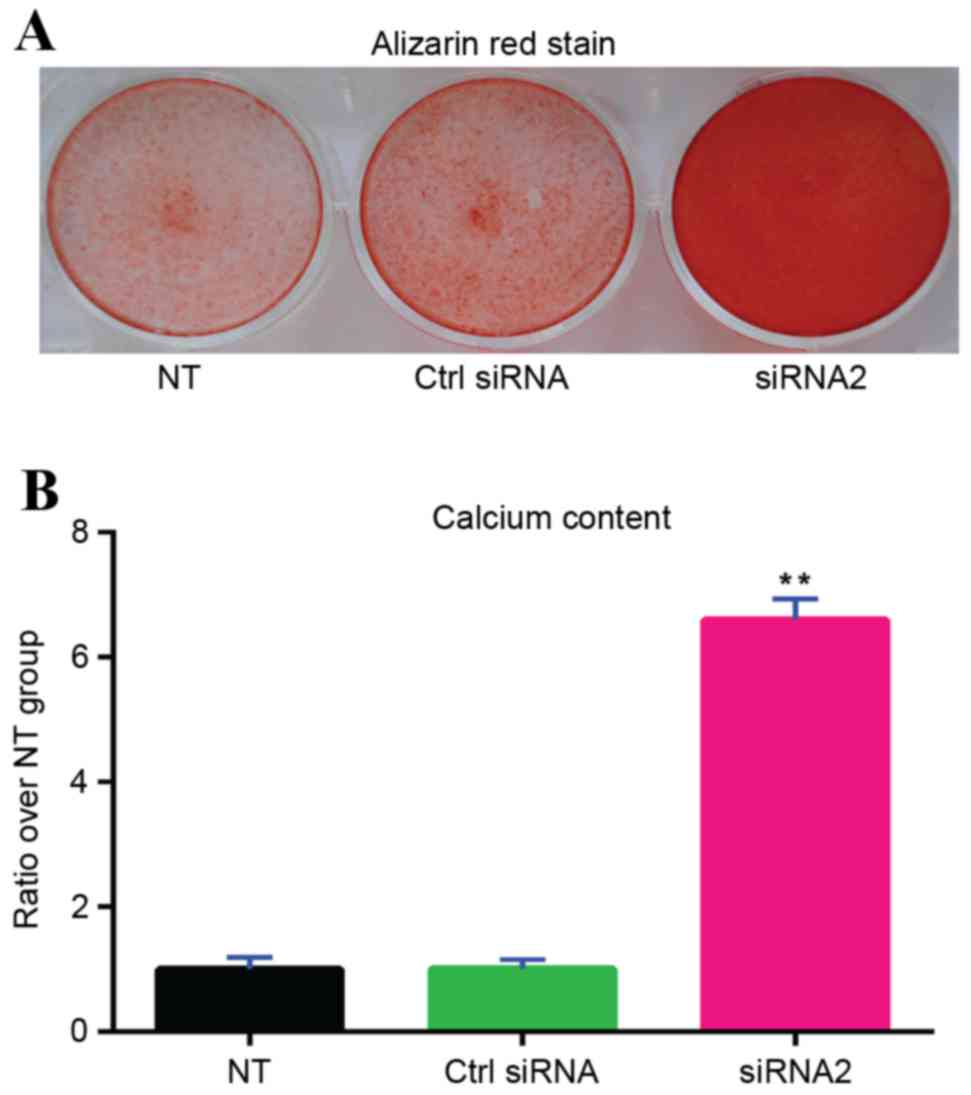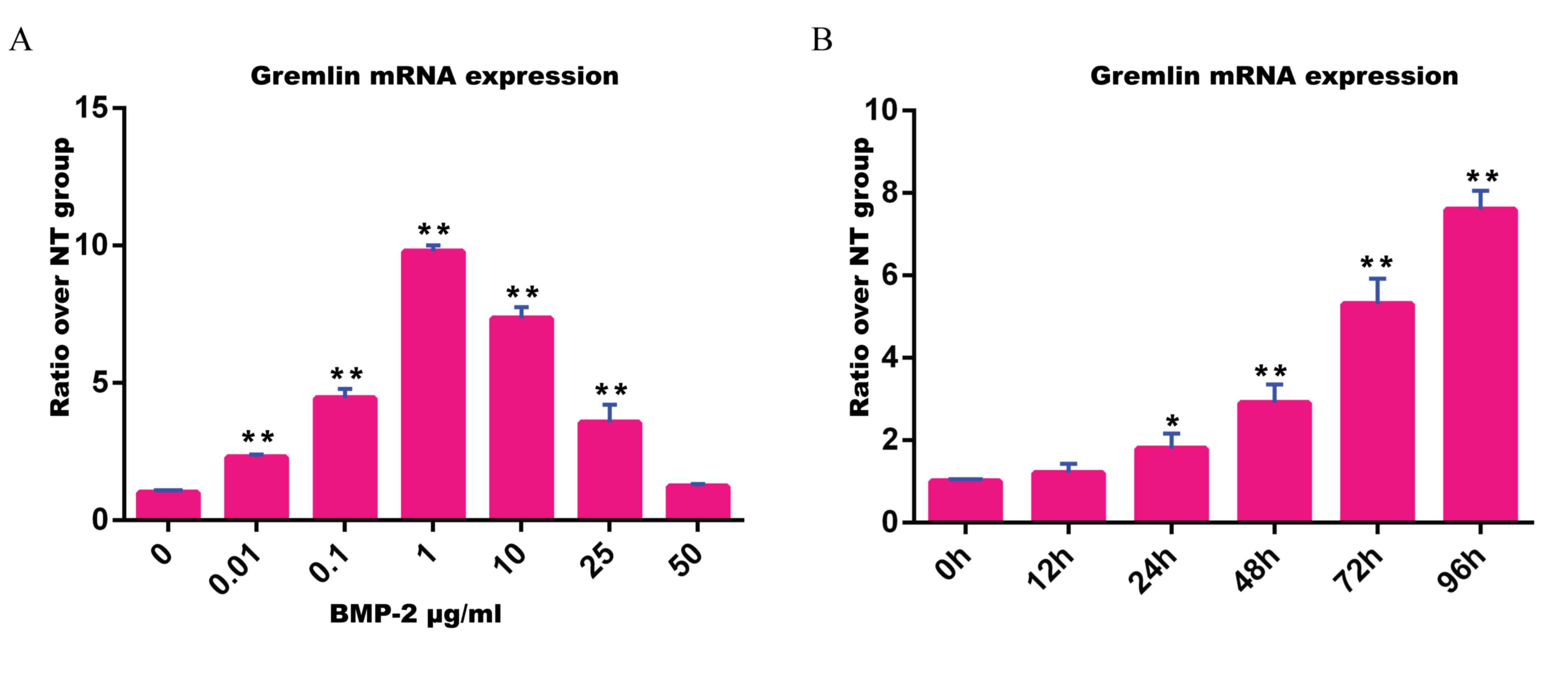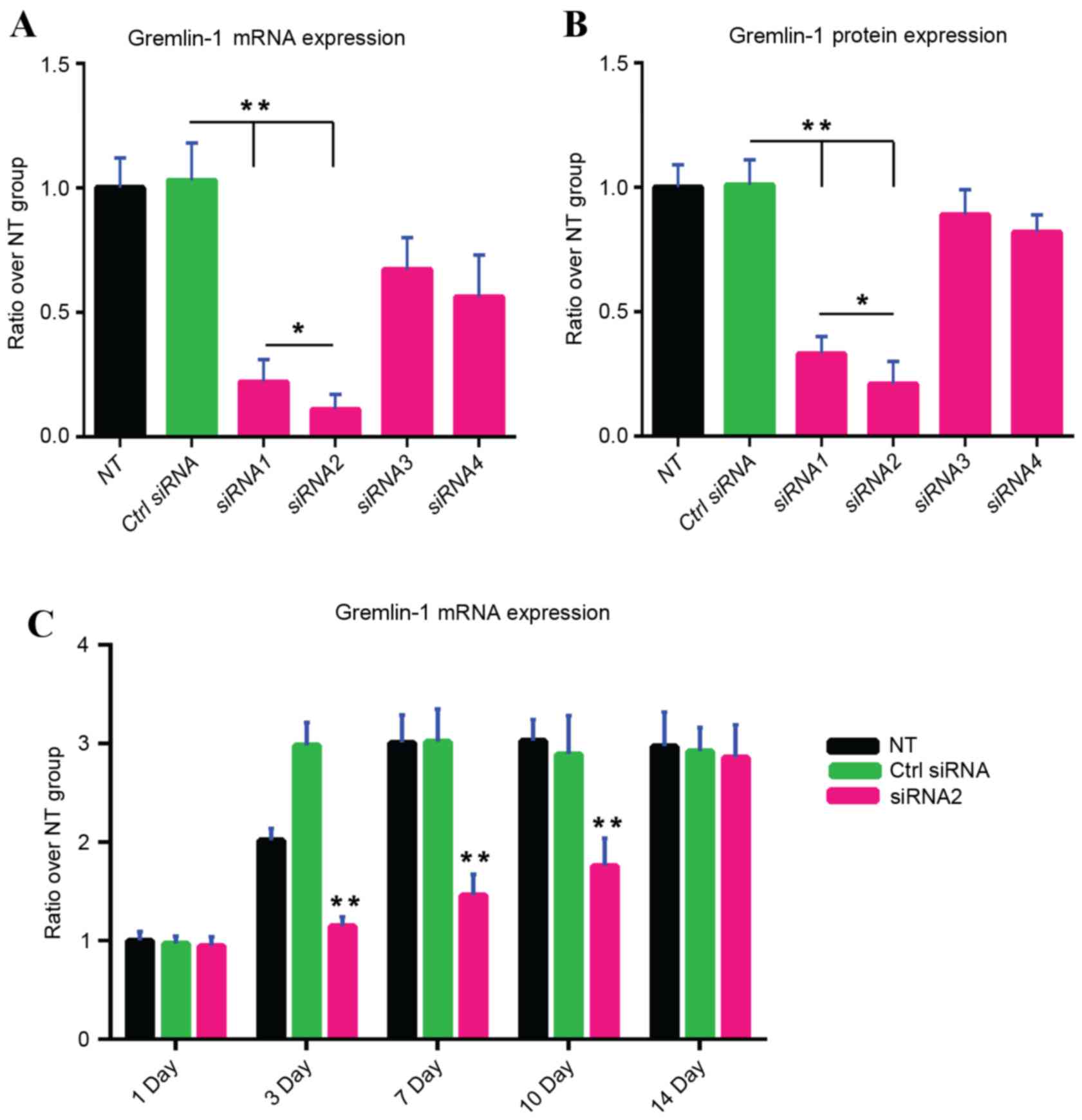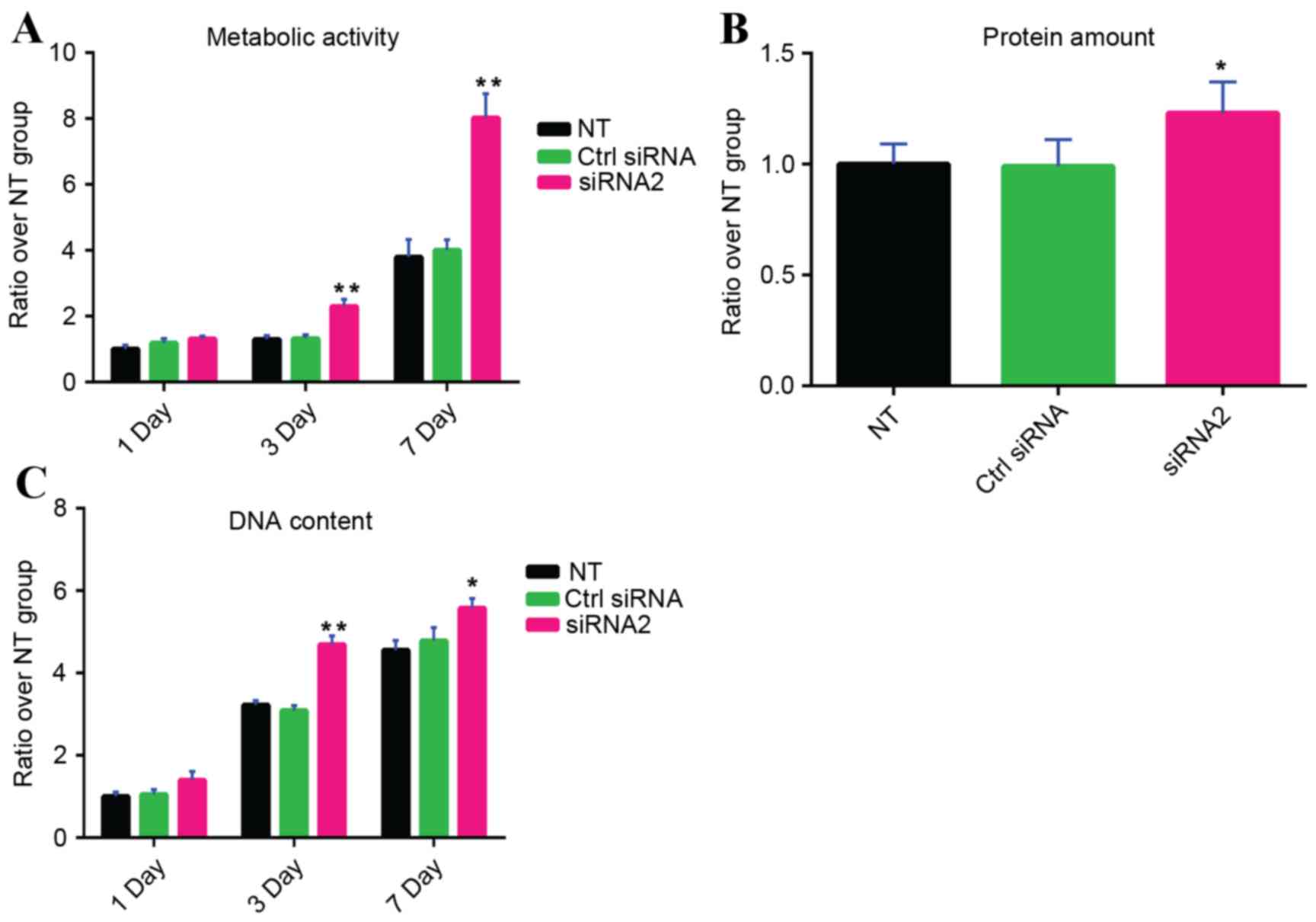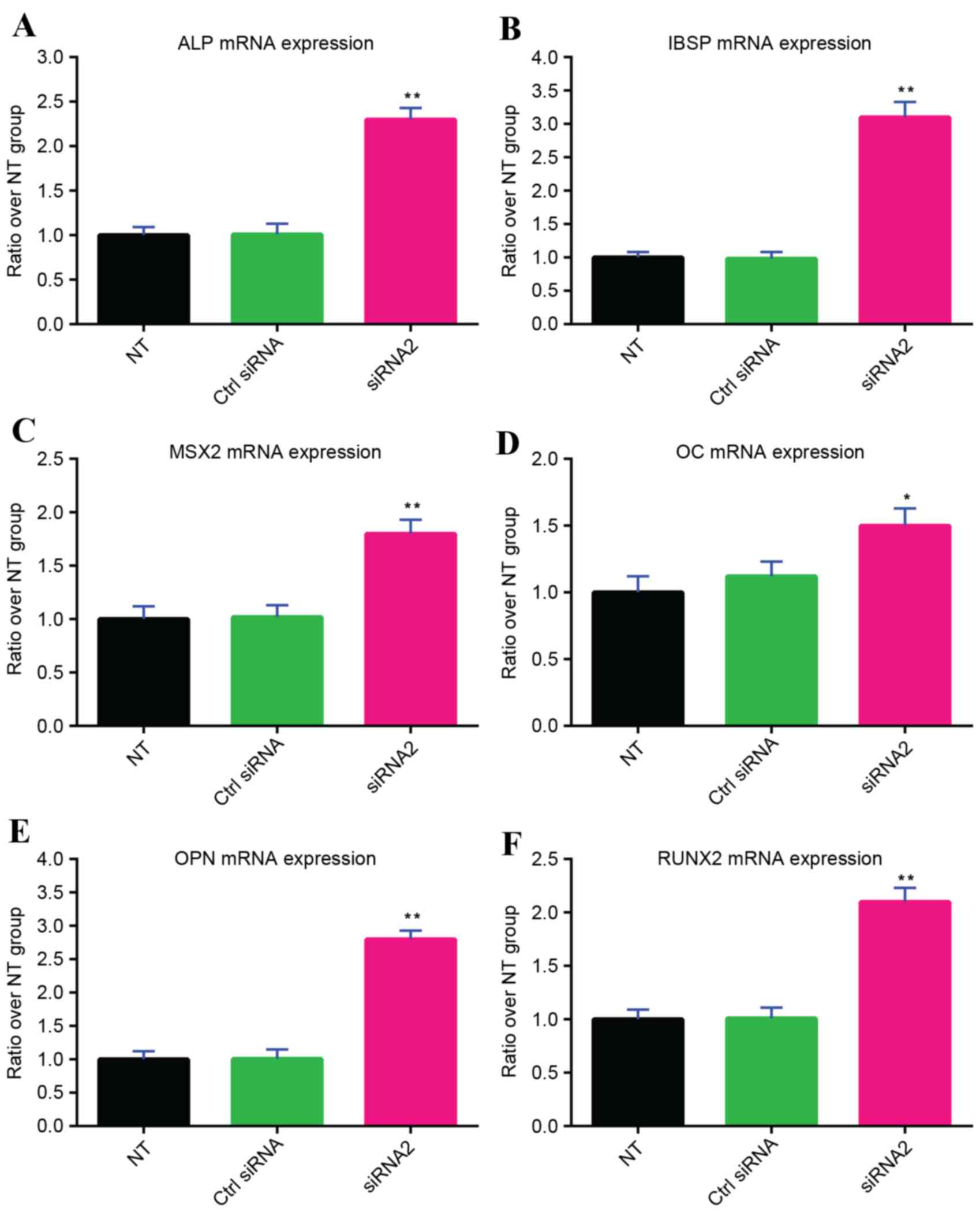Gremlin-1 suppression increases BMP-2-induced osteogenesis of human mesenchymal stem cells
- Authors:
- Published online on: February 28, 2017 https://doi.org/10.3892/mmr.2017.6253
- Pages: 2186-2194
-
Copyright: © Hu et al. This is an open access article distributed under the terms of Creative Commons Attribution License.
Abstract
Introduction
Mesenchymal stem cells (MSCs) migrate to the injury site following a fracture and differentiate into osteoblasts, which produce the bone matrix and repair the fractured bone (1). Multiple signals, including the potent osteoinductive signal induced by bone morphogenetic proteins (BMPs) regulate this process (2–4). It has been reported that BMP-2, 4, 6, 7 and 9 induce osteogenic differentiation of MSCs in vitro and in vivo (5–11). By binding to type 1 and 2 receptors on the surface of cells, BMPs exert their signals through the activation of intracellular Smad proteins. Then, by interacting with different transcription factors, the activated Smad protein complex regulates the expression of osteoblastic genes (12–14). BMP-mediated osteogenic differentiation is mediated by extracellular BMP antagonists, including noggin, gremlin-1, chordin and follistatin (15–18).
The function of gremlin-1 in BMP-regulated osteogenic differentiation has been previously investigated in rodent cells and animal models and the results have indicated that gremlin-1 is an inhibitor of osteogenesis. Gremlin-1 is a highly conserved glycoprotein with a molecular weight of 27 kDa belonging to the DAN/Cerberus family and was first isolated from Xenopus (19). Gremlin-1 is primarily distributed in the extracellular matrix, but a small amount of gremlin-1 is also distributed in the endoplasmic reticulum (20). Gremlin-1 combines with BMP-2, 4 and 7 and inhibits their association with the BMP receptors on the cell membrane (20). The expression of gremlin-1 was demonstrated to be reduced in tumor cells and contributed to the growth of tumor cells (21). Gremlin-1 is involved in the development of bone and kidney organs, and gremlin-1 mutant mice develop severe limb skeletal deformities (22–25). Mouse bone tissue-specific overexpression of gremlin-1 results in severe symptoms of osteoporosis; however, conditional knockout of gremlin-1 in bone tissue increases bone formation and trabecular bone volume (26). In osteoblasts, overexpression of gremlin-1 reduces the biological activity of BMP-2 and the use of RNA interference to reduce gremlin-1 expression in osteoblasts increases the biological activity of BMP-2 (26). Collectively, these studies demonstrate that the effects of gremlin-1 on BMP-induced osteogenesis of human MSCs remain elusive and further investigation into the involvement of gremlin-1 in osteogenesis of human MSCs is warranted. The present study was conducted to examine the effects of gremlin-1 suppression on cell viability and BMP-2-induced osteogenic differentiation of primary human MSCs in vitro.
Materials and methods
Isolation and culture of human MSCs
Bone marrow samples were obtained from 5 donor patients who underwent orthopedic surgery; written informed consent were obtained from all patients. The present study was approved by the Research Ethics Committee of The First Affiliated Hospital of Anhui Medical University (Hefei, China). Mononuclear cells from the bone marrow samples of the 5 patients were separated by centrifugation at 400 × g for 25 min at room temperature and Ficoll-Paque medium (GE Healthcare Life Sciences, Chalfont, UK) and then inoculated in MSC growth medium (MGM; high glucose Dulbecco's modified Eagle's medium [DMEM] containing 10% fetal bovine serum [FBS], 0.29 mg/ml GlutaMAX, 100 mg/ml streptomycin, 100 U/ml penicillin; all from Invitrogen; Thermo Fisher Scientific, Inc., Waltham, MA, USA), and 4 ng/ml basic fibroblast growth factor (Merck KGaA, Darmstadt, Germany) at a density of 4×105 cells/cm2. Following incubation for 3 days, non-adherent cells were discarded and adherent cells were washed twice using phosphate buffered saline (PBS; Invitrogen; Thermo Fisher Scientific, Inc.) and then cultured in MGM. The cells of each patient were either cultured for further examinations or frozen in liquid nitrogen in 1 ml aliquots 7 days later. Cells were cultured in a 5% CO2 and incubated at 37°C for all experiments. For each patient, all experiments were conducted in either triplicate or quadruplicate on individual cell cultures. The data generated from the individual cell cultures of these patients were collected and presented as combined data in the present study (mean ± standard deviation of n=5).
BMP-2 treatment
In order to determine whether BMP-2 induces gremlin-1 mRNA expression in human MSCs, dose-response and time-response studies were conducted. For the dose-response study, human MSCs were inoculated in 35 mm tissue culture dishes in MGM at a density of 7×103 cells/cm2. The medium was replaced 24 h later with the basal medium (DMEM containing 10% FBS, 100 mg/ml streptomycin, 100 U/ml penicillin and 0.29 mg/ml GlutaMAX; all from Invitrogen; Thermo Fisher Scientific, Inc.) containing different concentrations (0–50 mg/ml) of recombinant human BMP-2 (Medtronic, Dublin, Ireland). The cells were dyed with TRIzol reagent (Invitrogen; Thermo Fisher Scientific, Inc.) and then collected 72 h after BMP-2 treatment. Total RNA was extracted using the TRIzol reagent, and the expression of Gremlin-1 mRNA was analyzed by reverse transcription-quantitative polymerase chain reaction (RT-qPCR). Gremlin-1 expression levels were initially standardized by β-actin, and then transformed to a ratio over the control 0 mg/ml BMP-2 treatment group. For the time-course study, human MSCs cultured in 35 mm tissue culture dishes were treated with or without 0.1 mg/ml BMP-2, and cell samples were collected at 12, 24, 48, 72 and 96 h. Gremlin-1 expression levels were first standardized by β-actin, and then transformed to the ratio over the gremlin-1 expression levels at 0 h.
RT-qPCR
Total RNA was quantified with a NanoDrop ND-1000 spectrophotometer (Thermo Fisher Scientific, Inc., Wilmington, DE, USA), and was reverse transcribed into cDNA with the iScript cDNA synthesis kit (Bio-Rad Laboratories, Inc., Hercules, CA, USA). Reverse transcription was conducted in a 20 ml reaction volume with the following protocol: 25°C for 5 min, 42°C for 30 min and 85°C for 5 min. qPCR was conducted in quadruplicate using the iQ5 system (Bio-Rad Laboratories, Inc.). The reaction mixture had a volume of 25 ml and contained 10 ng cDNA, 1X iQ SYBR Green supermix (Bio-Rad Laboratories, Inc.) and 200 nM of each primer.
The primer sequences used in this study were as follows: β-actin, forward 5′-CATGTACGTTGCTATCCAGGC-3′ and reverse 5′-CTCCTTAATGTCACGCACGAT-3′; Gremlin-1, forward 5′-CGGAGCGCAAATACCTGAAG-3′ and reverse 5′-GGTTGATGATGGTGCGACTGT-3′; ALP, forward 5′-GTGAACCGCAACTGGTACTC-3′ and reverse 5′-GAGCTGCGTAGCGATGTCC-3′; OC, forward 5′-GAAGCCCAGCGGTGCA-3′ and reverse, 5′-CACTACCTCGCTGCCCTCC-3′; IBSP, forward 5′-CACTGGAGCCAATGCAGAAGA-3′ and reverse 5′-TGGTGGGGTTGTAGGTTCAAA-3′; OPN, forward 5′-CTCCATTGACTCGAACGACTC-3′ and reverse 5′-CAGGTCTGCGAAACTTCTTAGAT-3′; MSX2, forward 5′-ATGGCTTCTCCGTCCAAAGG-3′ and reverse 5′-CGGCTTCTTGTCGGACATGA-3′; RUNX2, forward 5′-TGGTTACTGTCATGGCGGGTA-3′ and reverse 5′-TCTCAGATCGTTGAACCTTGCTA-3′. qPCR was conducted with the following protocols: 1 cycle of 95°C for 3 min, followed by 45 cycles of 95°C for 10 sec, 58°C for 20 sec, and 72°C for 10 sec. All amplifications were normalized by β-actin. Data were analyzed using the comparison Cq (2−ΔΔCq) method (27) and expressed as fold change compared to respective control (28).
Assessment of gremlin-1 small interfering RNA (siRNA) efficacy
Four synthetic siRNAs (Qiagen, Inc., Valencia, CA, USA), which were designed to target multiple regions of human gremlin-1 mRNA (gene accession number: NM_001191322.1), were obtained and their sequence information is listed in Table I. Human MSCs were transfected with control siRNA and gremlin-1 siRNAs by Lipofectamine 2000 (Thermo Fisher Scientific, Inc.) under the optimized condition of transfection studied previously to validate the knockdown efficacy of the gremlin-1 siRNAs (28). In total, 6 groups were designed in triplicate: i) Non-transfected MSCs (NT control group); ii) MSCs transfected with control siRNA (control siRNA group); iii) MSCs transfected with gremlin-1 siRNA1 (siRNA1 group); iv) MSCs transfected with gremlin-1 siRNA2 (siRNA2 group); v) MSCs transfected with gremlin-1 siRNA3 (siRNA3 group); and vi) MSCs transfected with gremlin-1 siRNA4 (siRNA4 group). Following transfection for 24 h, MSCs were transferred to the basal medium containing 0.1 mg/ml BMP-2. Total RNA was extracted 72 h following treatment with BMP-2 using TRIzol reagent according to the manufacturer's protocols and gremlin-1 mRNA expression was assessed by RT-qPCR. Gremlin-1 protein expression levels in the culture supernatant were calculated using a commercial enzyme linked immunosorbent assay kit for human gremlin-1 (EK1292; Wuhan Uscn Business Co., Ltd., Wuhan, Hubei, China) 72 h after treatment with BMP-2. The most effective gremlin-1 siRNA to inhibit gremlin-1 mRNA and protein expression levels was selected for the following studies. To examine the duration of gremlin-1 inhibition resulting from a single transfection of gremlin-1 siRNA in the presence of BMP-2, a time-course study in which gremlin-1 expression was analyzed following siRNA transfection was performed. Initially, samples were collected to measure the baseline of gremlin-1 expression (day 0) prior to transfection. For the transfection, three groups were constructed in triplicate: One group without transfection (NT control); one group transfected with control siRNA (control siRNA); and one group transfected with the most effective gremlin-1 siRNA. The medium was replaced after a 24 h period of transfection with basal medium containing 0.1 mg/ml BMP-2, and this medium was replaced twice a week. Cell samples were collected on days 1, 3, 7, 10 and 14. Total RNA was extracted using TRIzol reagent according to manufacturer's protocols at the indicated time points to perform RT-qPCR, in order to assess the mRNA expression levels of gremlin-1 at these time points.
Water soluble tetrazolium salt-8 (WST-8) assay
Human MSCs were inoculated in 48-well plates in quadruplicate with a density of 5.5×103 cells/cm2. Following culture for 24 h, human MSCs in 300 ml medium were transfected with control siRNA or the most effective gremlin-1 siRNA. The medium was altered 24 h later with basal medium containing 0.1 mg/ml BMP-2. The metabolism of human MSCs was estimated on days 1, 3 and 7. The WST-8 (2-(2-methoxy-4-nitrophenyl)-3-(4-nitrophenyl)-5-(2,4-disulfophenyl)-2H-tetrazolium, monosodium salt; Cedarlane Laboratories Ltd., Burlington, Canada) reagent is designed to estimate the activity of mitochondrial dehydrogenase in human MSCs. WST-8 is decreased by mitochondrial dehydrogenases in viable cells to produce a soluble yellow formazan, which is directly proportional to the reduced activity of the cells, and thus is used as a measurement of total cellular metabolic activity. WST-8 solution (30 µl) was added to 300 µl medium containing human MSCs (1.0×104), and incubated for a further 3 h. Following this, the absorbance was measured at 450 nm with an absorbance microplate reader (BioTek Instruments, Inc., Winooski, VT, USA) and the reference wavelength was 650 nm. The ratios between the data of individual patients and the non-transfection group were calculated and then the data of all five patients were combined.
DNA content analysis
The human MSCs were inoculated in 96-well plates in quadruplicate at a density of 3×103 cells/cm2. Following culture for 24 h, human MSCs were transfected with control siRNA or the most effective gremlin-1 siRNA. The medium was replaced with basal medium with 0.1 mg/ml BMP-2 24 h later. Cells were dyed using a CyQUANT Cell Proliferation Assay kit (Invitrogen; Thermo Fisher Scientific, Inc.) and samples were gathered on days 0, 3 and 6. The DNA content was measured with an emission wavelength of 530 nm and an excitation wavelength of 450 nm. The ratios between the data of individual patients and the non-transfection group were first calculated and then data of all 5 patients were combined.
Induction of osteogenic differentiation of human MSCs
To estimate the influence of gremlin-1 inhibition on osteogenic differentiation in human MSCs, gremlin-1 expression was knocked down in human MSCs, and human MSCs were induced to perform osteogenic differentiation in osteogenic medium [DMEM with 10% FBS, 100 mg/ml streptomycin, 100 U/ml penicillin, 0.29 mg/ml L-glutamine (all from Invitrogen; Thermo Fisher Scientific, Inc.), 5 mM b-glycerolphosphate, 10 nM dexamethasone, and 50 mg/l ascorbic acid-2-phosphate (all from Sigma-Aldrich, Merck KGaA)] which contained 0.1 mg/ml BMP-2 in 12-well plates. Three study groups were constructed: One group with no transfection (NT control); one group transfected with control siRNA (control siRNA); and one group transfected with the most effective gremlin-1 siRNA. All three groups were treated with osteogenic medium with 0.1 mg/ml BMP-2 24 h post transfection. siRNA transfection was repeated every 7 days, as advised by the manufacturer (Qiagen, Inc.) to cause prolonged silencing of gremlin-1. The following experiments were conducted to assess osteogenic differentiation
RT-qPCR analysis of osteoblastic genes
On day 14 of osteogenic induction, cell samples were gathered, total RNA was extracted using TRIzol reagent and reverse transcription was conducted as described above. Expression levels of osteoblastic genes including alkaline phosphatase (ALP), msh homeobox 2 (MSX2), integrin-binding sialoprotein (IBSP), osteocalcin (OC), runt related transcription factor 2 (RUNX2) and osteopontin (OPN) were detected by RT-qPCR. Human β-actin, used as the endogenous reference gene, standardized the osteoblastic gene expression. Following standardization, the ratio between the data of individual patients and the non-transfection group were first calculated and then data of all 5 patients were combined. Gremlin-1 expression levels were also measured to confirm the inhibition of gremlin-1 on day 14.
ALP staining
On day 14 of osteogenic induction, ALP staining was conducted using a Fast Naphthol phosphate kit (Sigma-Aldrich; Merck KGaA). Cells were washed three times using PBS and were subsequently fixed for 30 sec by citrate-acetone-formaldehyde fixative. Samples were then rinsed with deionized water in order to be stained in the dark for 15 min, and counterstained with neutral red solution for 2 min (Fig. 5). Samples were then washed three times using tap water to remove the dissociative dye. The experiment was repeated three times independently.
ALP activity assay
On day 14 of osteogenic induction, the activity of ALP was quantitatively measured using a commercial phosphatase assay kit (BioAssay Systems, Hayward, CA, USA). Lysis buffer (containing 50 mM Tris-HCl, 0.5% Triton and 5 mM MgCl2; Sigma-Aldrich; Merck KGaA) was used to lyse the cells in triplicate. The lysate was then moved to 96-well plates and incubated with ALP substrate at 37°C for 30 min in the dark. Stop buffer (0.1 M NaOH) was then added to halt the reaction. The p-nitrophenol product, which was generated by enzymatic hydrolysis of p-nitrophenylphosphate substrate was detected at 405 nm using an absorbance microplate reader (BioTek Instruments, Inc.). The protein concentration of samples was tested using a detergent compatible protein assay kit (Bio-Rad Laboratories, Inc.) and FBS (Bio-Rad Laboratories, Inc.), and a standard curve was created to transform data. Concentration of ALP was standardized by total protein amount. The ratio between the data of individual patients and the non-transfection group were first calculated and then the data of all 5 patients were combined.
Alizarin Red staining
On day 28 of osteogenic induction, cells and the extracellular matrix from all groups were fixed in 75% ethanol at 48°C for 1 h, washed with distilled water, and stained with Alizarin Red S solution (Sigma-Aldrich; Merck KGaA) until an orange-red color appeared (Fig. 6). Samples were then rinsed three times with deionized water, and washed once with PBS.
Calcium assay
On day 28 of osteogenic induction, 600 ml 0.5 N hydrochloric acid solution was added to each well (12-well plates) to demineralize the cells and the extracellular matrix secreted by the cells, which were then incubated at 48°C overnight. Following centrifugation of the samples at 10,000 × g for 10 min, the supernatant containing calcium extracts was gathered. The calcium concentration was examined using the QuantiChrom Calcium Assay kit (BioAssay Systems). The ratio between the data of individual patients and the non-transfection group were first calculated and then the data of all 5 patients were combined.
Statistical analysis
Data are presented as the mean ± standard error and were analyzed by Student's t-test or one-way analysis of variance followed by the Bonferroni post hoc test, as appropriate. All tests were two-tailed, with P<0.05 considered to indicate a statistically significant difference. All statistical analyses were conducted with PASW Statistics version 18.0 (SPSS Inc., Chicago, IL, USA).
Results
BMP-2 induces gremlin-1 mRNA expression
Gremlin-1 mRNA expression was increased by BMP-2, and the peak expression appeared when induced with 1 mg/ml BMP-2 (Fig. 1A). Increasing concentrations of BMP-2 resulted in increasing gremlin-1 mRNA expression levels within the range from 0.01–1 mg/ml BMP-2, whereas the induction of gremlin-1 expression was reduced as the concentration of BMP-2 rose from 1 to 50 mg/ml (Fig. 1A). There was no significant difference in the level of gremlin-1 expression between the group without BMP-2 treatment and the group treated with 50 mg/ml BMP-2 (P>0.05; Fig. 1A).
Gremlin-1 mRNA expression was also induced by 0.1 mg/ml BMP-2 in a time-dependent manner. Gremlin-1 mRNA expression levels increased with time and at 24, 48, 72 and 96 h following BMP-2 treatment the increase was significantly higher than the group without BMP-2 treatment (P<0.05, P<0.01, P<0.01 and P<0.01, respectively; Fig. 1B).
Suppression of BMP-2-induced gremlin-1 expression by gremlin-1 siRNA transfection
Following the examination of all transfection conditions, the optimal condition was 20 nM (final concentration) of siRNA duplex with 3 µl Lipofectamine RNAiMAX in 1 ml medium for each well of the 12-well tissue culture plates, which produced the highest mean fluorescence intensity and the highest percentage of siRNA-positive cells in the transfected cells. The following siRNA transfection studies were performed under this optimal condition. Compared with the non-transfected group, gremlin-1 mRNA (Fig. 2A) and protein (Fig. 2B) levels were not changed by transfection with control siRNA. By contrast, gremlin-1 mRNA expression levels in human MSCs and gremlin-1 protein levels in the culture supernatant were significantly reduced by the transfection of gremlin-1 siRNA1 (P<0.01 and P<0.01, respectively; Fig. 2A and B, respectively) and siRNA2 (P<0.01 and P<0.01, respectively; Fig. 2A and B, respectively). Gremlin-1 mRNA and protein expression were not altered by transfection of gremlin-1 siRNA3 and siRNA4 (Fig. 2A and B). As gremlin-1 mRNA and protein expression levels were significantly more inhibited with gremlin-1 siRNA1 compared with gremlin-1 siRNA1 (P<0.05 and P<0.05, respectively; Fig. 2A and B, respectively), further experiments were conducted with gremlin-1 siRNA2 only. A single gremlin-1 siRNA2 transfection significantly inhibited BMP-2 induced gremlin-1 expression on days 3, 7 and 10 compared with the untransfected group and the control siRNA group, but the inhibitive effect was not evident on day 14 (Fig. 2C).
Increased viability of human MSCs by gremlin-1 suppression
Following siRNA transfection, the WST-8 assay indicated that metabolism of MSCs was significantly increased by transfection with gremlin-1 siRNA2 on days 3 and 7 compared with the untransfected group and the control siRNA group (P<0.01; Fig. 3A). The total protein content in the group transfected with gremlin-1 siRNA2-was also significantly higher compared with the untransfected group and the control siRNA group on day 14 (P<0.05; Fig. 3B). In addition, following siRNA transfection, the total DNA content was significantly increased by gremlin-1 siRNA2 on days 3 and 7 compared with the untransfected group and the control siRNA group (day 3, P<0.01 and P<0.01, respectively; day 7, P<0.05 and P<0.05, respectively; Fig. 3C).
Increased osteogenic differentiation of human MSCs by gremlin-1 suppression
siRNA transfection was performed every 7 days during the osteogenic differentiation of human MSCs, as the inhibitive effect of a single gremlin-1 siRNA2 transfection lasted for a maximum of 7 days (Fig. 2C). Gremlin-1 siRNA2 significantly increased the mRNA expression levels of all osteoplastic genes examined, including ALP (P<0.01; Fig. 4A), IBSP (P<0.01; Fig. 4B), MSX2 (P<0.01; Fig. 4C), OC (P<0.05; Fig. 4D), OPN (P<0.01; Fig. 4E) and RUNX2 (P<0.01; Fig. 4F) compared with the untransfected group and the control siRNA group. The qualitative naphthol phosphate staining test indicated that following 14 days of osteogenic induction, transfection of gremlin-1 siRNA2 increased the ALP activity of the cells (Fig. 5A). Similar results were obtained in the quantitative ALP assay, which revealed that transfection of gremlin-1 siRNA2 significantly increased ALP activity of the MSCs compared with the untransfected group and the control siRNA group (P<0.01; Fig. 5B).
Qualitative Alizarin Red staining indicated that compared with the untransfected group and the control siRNA group, more calcium deposits were observed in the group transfected with gremlin-1 siRNA2 (Fig. 6A). The results of the quantitative calcium assay demonstrated that gremlin-1 siRNA2 transfection significantly increased calcium deposits in MSCs compared with the untransfected group and the control siRNA group (P<0.01; Fig. 6B).
Discussion
The results of the present study suggested that gremlin-1 inhibition improved viability and osteogenic differentiation of human MSCs by BMP-2-inducement. These results add to the understanding of the involvement of gremlin-1 in human MSC osteogenesis, and imply that gremlin-1 may inhibit bone formation in humans. In human MSC cultures, gremlin-1 expression was induced by BMP-2 in experiments of dose- and time-dependence. To the best of our knowledge, the present study is the first to observe the biophysical nature of time-dependent gremlin-1 induction by BMP-2, and the variable effect depending on the dose. The induction of gremlin-1 was enhanced by BMP-2 within the concentrations from 0.01–1 mg/ml, although the induction was decreased at concentrations of BMP-2 from 1–50 mg/ml (Fig. 1). However, the reason why BMP-2 concentrations >1 mg/ml reduces gremlin-1 induction remains to be elucidated. DNA content, cellular metabolism and protein content of human MSCs were increased by gremlin-1 inhibition, and this influence was unlikely to result from the transfection system as the transfection of control siRNA did not change these features of human MSCs in culture (Fig. 3A-C). These data suggest that gremlin-1 is involved in proliferation of stem cells. Although the data indicated that gremlin-1 inhibition increased the viability of human MSCs, the expression levels of osteoblastic genes and the increased ALP induction on day 14 may have been the secondary effect of gremlin-1 inhibition on cell viability, as expression levels of osteoblastic genes in the present study were standardized by β-actin from the matching group, and the concentration of ALP was standardized by the total protein amount. An increase in osteogenic activity was still apparent following such standardization, so the differences cannot be explained by stagnated cell growth alone. The expression levels of osteoblastic genes and increased ALP production by gremlin-1 inhibition indicated increased osteogenic differentiation on a per cell basis. Nevertheless, the number of calcium deposits was not standardized, and therefore the enhanced calcium deposits caused by gremlin-1 inhibition may be partly due to increased cell growth. The inhibition of gremlin-1 expression by a single transfection of gremlin-1 siRNA2 in the present study was maintained for a maximum of 7 days (Fig. 2C). Based on this observation, gremlin-1 siRNA2 was used to transfect cells every 7 days during the period of osteogenic induction, so as to knock down the expression of gremlin-1 constantly. Repeated transfections of gremlin-1 siRNA2 continuously inhibited gremlin-1 expression.
Instead of studying the influence of exogenous gremlin-1 addition, the present study illustrated the influence of endogenous gremlin-1 on BMP-2-induced osteogenesis in human MSCs via the knockdown of endogenous gremlin-1 expression. The different observations between studies using human MSCs and rodent cells or animal models indicate that a species-specific difference in BMP-2-induced osteogenesis-associated functions of gremlin-1 in MSCs may exist. Dexamethasone and BMP-2 resulted in different osteoinductive effects on MSCs of humans, rats, and mice (29). Rat MSCs expressed mRNA for activin receptor-like kinase-6, a type 1 receptor for BMPs, but MSCs from humans did not express this particular receptor (30). In human MSCs, MSX2 was upregulated up to 10-fold by BMP-2, but in rat MSCs expression of MSX2 was not altered by BMP-2 (30). These observations and the data from the present study suggest that a species-specific difference may exist when gremlin-1 functions in BMP-2-induced osteogenesis of MSCs.
The present study indicated that in the presence of BMP-2, gremlin-1 is harmful to osteogenic differentiation in human MSCs. One of the possible mechanisms may be that BMP-2 is not inactivated by gremlin-1 that is already bound to BMP-2 in human MSC cultures. Gremlin-1 is known to bind to proteoglycans on the surface of cell. In addition, regarding the possible intracellular signaling, based on the following observations gremlin-1 may partly regulate osteogenic differentiation by modulating the intracellular canonical BMP/Smad signaling, then MSX2, RUNX2, or other unidentified transcription factors, followed by the subsequent gene expression of OC, IBSP, OPN and ALP. A previous report (31) has demonstrated that gremlin-1 actively inhibits BMP-2 and the production of its type 2 receptor. The data from the present study suggested that gremlin-1 inhibition increased the expression of MSX2 and RUNX2, which are important transcription factors in the process of osteogenic differentiation. In addition, the expression levels of the osteoblastic markers IBSP, OC, ALP and OPN were all increased by gremlin-1 inhibition (Fig. 4). Further studies are required regarding the intracellular signaling pathways through which gremlin-1 regulates osteogenic differentiation in human MSCs.
In conclusion, expression of gremlin-1 in human MSCs was upregulated by BMP-2 in a time-dependent manner, with the effect of dose being variable. Gremlin-1 inhibition increased BMP-2-induced osteogenic differentiation and viability in human MSC culture, which indicates that gremlin-1 has an inhibitory effect on human MSC osteogenesis. The underlying mechanisms that resulted in these observations remain unknown, and further studies are needed to clarify the intracellular signaling pathways through which gremlin-1 regulates osteogenic differentiation in human MSCs. In addition, similar studies with a larger sample size on human MSCs are important to discover whether there is any significant difference between different sexes in response to gremlin-1 inhibition.
Acknowledgements
The present study was supported by a grant from the Anhui Natural Science Foundation (grant no. 1408085MH182).
References
|
Granero-Moltó F, Weis JA, Miga MI, Landis B, Myers TJ, O'Rear L, Longobardi L, Jansen ED, Mortlock DP and Spagnoli A: Regenerative effects of transplanted mesenchymal stem cells in fracture healing. Stem Cells. 27:1887–1898. 2009. View Article : Google Scholar : PubMed/NCBI | |
|
Marie PJ and Fromigué O: Osteogenic differentiation of human marrow-derived mesenchymal stem cells. Regen Med. 1:539–548. 2006. View Article : Google Scholar : PubMed/NCBI | |
|
Koehler KC, Alge DL, Anseth KS and Bowman CN: A Diels-Alder modulated approach to control and sustain the release of dexamethasone and induce osteogenic differentiation of human mesenchymal stem cells. Biomaterials. 34:4150–4158. 2013. View Article : Google Scholar : PubMed/NCBI | |
|
Yokota J, Chosa N, Sawada S, Okubo N, Takahashi N, Hasegawa T, Kondo H and Ishisaki A: PDGF-induced PI3K-mediated signaling enhances the TGF-β-induced osteogenic differentiation of human mesenchymal stem cells in a TGF-β-activated MEK-dependent manner. Int J Mol Med. 33:534–542. 2014.PubMed/NCBI | |
|
Tsuji K, Bandyopadhyay A, Harfe BD, Cox K, Kakar S, Gerstenfeld L, Einhorn T, Tabin CJ and Rosen V: BMP2 activity, although dispensable for bone formation, is required for the initiation of fracture healing. Nat Genet. 38:1424–1429. 2006. View Article : Google Scholar : PubMed/NCBI | |
|
Lin L, Fu X, Zhang X, Chen LX, Zhang JY, Yu CL, Ma KT and Zhou CY: Rat adipose-derived stromal cells expressing BMP4 induce ectopic bone formation in vitro and in vivo. Acta Pharmacol Sin. 27:1608–1615. 2006. View Article : Google Scholar : PubMed/NCBI | |
|
Kotajima S, Kishimoto KN, Watanuki M, Hatori M and Kokubun S: Gene expression analysis of ectopic bone formation induced by electroporatic gene transfer of BMP4. Ups J Med Sci. 111:231–241. 2006. View Article : Google Scholar : PubMed/NCBI | |
|
Kugimiya F, Kawaguchi H, Kamekura S, Chikuda H, Ohba S, Yano F, Ogata N, Katagiri T, Harada Y, Azuma Y, et al: Involvement of endogenous bone morphogenetic protein (BMP) 2 and BMP6 in bone formation. J Biol Chem. 280:35704–35712. 2005. View Article : Google Scholar : PubMed/NCBI | |
|
Tsuji K, Cox K, Gamer L, Graf D, Economides A and Rosen V: Conditional deletion of BMP7 from the limb skeleton does not affect bone formation or fracture repair. J Orthop Res. 28:384–389. 2010.PubMed/NCBI | |
|
Levet S, Ciais D, Merdzhanova G, Mallet C, Zimmers TA, Lee SJ, Navarro FP, Texier I, Feige JJ, Bailly S and Vittet D: Bone morphogenetic protein 9 (BMP9) controls lymphatic vessel maturation and valve formation. Blood. 122:598–607. 2013. View Article : Google Scholar : PubMed/NCBI | |
|
Kang Q, Song WX, Luo Q, Tang N, Luo J, Luo X, Chen J, Bi Y, He BC, Park JK, et al: A comprehensive analysis of the dual roles of BMPs in regulating adipogenic and osteogenic differentiation of mesenchymal progenitor cells. Stem Cells Dev. 18:545–559. 2009. View Article : Google Scholar : PubMed/NCBI | |
|
Shi Y and Massagué J: Mechanisms of TGF-beta signaling from cell membrane to the nucleus. Cell. 113:685–700. 2003. View Article : Google Scholar : PubMed/NCBI | |
|
Foletta VC, Lim MA, Soosairajah J, Kelly AP, Stanley EG, Shannon M, He W, Das S, Massague J and Bernard O: Direct signaling by the BMP type II receptor via the cytoskeletal regulator LIMK1. J Cell Biol. 162:1089–1098. 2003. View Article : Google Scholar : PubMed/NCBI | |
|
Lavery K, Swain P, Falb D and Alaoui-Ismaili MH: BMP-2/4 and BMP-6/7 differentially utilize cell surface receptors to induce osteoblastic differentiation of human bone marrow-derived mesenchymal stem cells. J Biol Chem. 283:20948–20958. 2008. View Article : Google Scholar : PubMed/NCBI | |
|
Ali IH and Brazil DP: Bone morphogenetic proteins and their antagonists: Current and emerging clinical uses. Br J Pharmacol. 171:3620–3632. 2014. View Article : Google Scholar : PubMed/NCBI | |
|
Passa O, Tsalavos S, Belyaev NN, Petryk A, Potocnik AJ and Graf D: Compartmentalization of bone morphogenetic proteins and their antagonists in lymphoid progenitors and supporting microenvironments and functional implications. Immunology. 134:349–359. 2011. View Article : Google Scholar : PubMed/NCBI | |
|
Yanagita M: Antagonists of bone morphogenetic proteins in kidney disease. Curr Opin Investig Drugs. 11:315–322. 2010.PubMed/NCBI | |
|
Dean DB, Watson JT, Moed BR and Zhang Z: Role of bone morphogenetic proteins and their antagonists in healing of bone fracture. Front Biosci (Landmark Ed). 14:2878–2888. 2009. View Article : Google Scholar : PubMed/NCBI | |
|
Hsu DR, Economides AN, Wang X, Eimon PM and Harland RM: The Xenopus dorsalizing factor Gremlin identifies a novel family of secreted proteins that antagonize BMP activities. Mol Cell. 1:673–683. 1998. View Article : Google Scholar : PubMed/NCBI | |
|
Topol LZ, Bardot B, Zhang Q, Resau J, Huillard E, Marx M, Calothy G and Blair DG: Biosynthesis, post-translation modification, and functional characterization of Drm/Gremlin. J Biol Chem. 275:8785–8793. 2000. View Article : Google Scholar : PubMed/NCBI | |
|
Karagiannis GS, Musrap N, Saraon P, Treacy A, Schaeffer DF, Kirsch R, Riddell RH and Diamandis EP: Bone morphogenetic protein antagonist gremlin-1 regulates colon cancer progression. Biol Chem. 396:163–183. 2015. View Article : Google Scholar : PubMed/NCBI | |
|
Khokha MK, Hsu D, Brunet LJ, Dionne MS and Harland RM: Gremlin is the BMP antagonist required for maintenance of Shh and Fgf signals during limb patterning. Nat Genet. 34:303–307. 2003. View Article : Google Scholar : PubMed/NCBI | |
|
Lappin DW, McMahon R, Murphy M and Brady HR: Gremlin: An example of the re-emergence of developmental programmes in diabetic nephropathy. Nephrol Dial Transplant. 17 Suppl 9:S65–S67. 2002. View Article : Google Scholar | |
|
Bardot B, Lecoin L, Fliniaux I, Huillard E, Marx M and Viallet JP: Drm/Gremlin, a BMP antagonist, defines the interbud region during feather development. Int J Dev Biol. 48:149–156. 2004. View Article : Google Scholar : PubMed/NCBI | |
|
Michos O, Panman L, Vintersten K, Beier K, Zeller R and Zuniga A: Gremlin-mediated BMP antagonism induces the epithelial-mesenchymal feedback signaling controlling metanephric kidney and limb organogenesis. Development. 131:3401–3410. 2004. View Article : Google Scholar : PubMed/NCBI | |
|
Gazzerro E, Smerdel-Ramoya A, Zanotti S, Stadmeyer L, Durant D, Economides AN and Canalis E: Conditional deletion of gremlin causes a transient increase in bone formation and bone mass. J Biol Chem. 282:31549–31557. 2007. View Article : Google Scholar : PubMed/NCBI | |
|
Livak KJ and Schmittgen TD: Analysis of relative gene expression data using real-time quantitative PCR and the 2(−Delta Delta C(T)) Method. Methods. 25:402–408. 2001. View Article : Google Scholar : PubMed/NCBI | |
|
Zuo B, Zhu J, Li J, Wang C, Zhao X, Cai G, Li Z, Peng J, Wang P, Shen C, et al: microRNA-103a functions as a mechanosensitive microRNA to inhibit bone formation through targeting Runx2. J Bone Miner Res. 30:330–345. 2015. View Article : Google Scholar : PubMed/NCBI | |
|
Diefenderfer DL, Osyczka AM, Reilly GC and Leboy PS: BMP responsiveness in human mesenchymal stem cells. Connect Tissue Res. 44 Suppl 1:S305–S311. 2003. View Article : Google Scholar | |
|
Osyczka AM, Diefenderfer DL, Bhargave G and Leboy PS: Different effects of BMP-2 on marrow stromal cells from human and rat bone. Cells Tissues Organs. 176:109–119. 2004. View Article : Google Scholar : PubMed/NCBI | |
|
Wellbrock J, Harbaum L, Stamm H, Hennigs JK, Schulz B, Klose H, Bokemeyer C, Fiedler W and Lüneburg N: Intrinsic BMP antagonist gremlin-1 as a novel circulating marker in pulmonary arterial hypertension. Lung. 193:567–570. 2015. View Article : Google Scholar : PubMed/NCBI |



